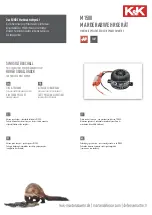
User's Guide
SLUUAA8 – September 2013
User's Guide for bq25505 Battery Charger Evaluation
Module for Energy Harvesting
This user’s guide describes the bq25505 evaluation module (EVM), how to perform a stand-alone
evaluation and how to allow the EVM to interface with the system and host. The boost charger output is
configured to deliver up to 4.2-V maximum voltage to its output, VSTOR, using external resistors. This
voltage is applied to the storage element as long as the storage element voltage at VBAT_SEC is above
the internally programmed undervoltage of 2 V. The VBAT_OK indicator toggles high when VSTOR ramps
up to 3 V and toggles low when VSTOR ramps down to 2.8 V.
Contents
1
Introduction
...................................................................................................................
1.1
EVM Features
.......................................................................................................
1.2
General Description
................................................................................................
1.3
Design and Evaluation Considerations
..........................................................................
1.4
bq25505EVM Schematic
...........................................................................................
1.5
EVM I/O Connections
..............................................................................................
2
EVM Performance Specification Summary
...............................................................................
3
Test and Measurement Summary
.........................................................................................
3.1
Test Setups and Results
...........................................................................................
4
Bill of Materials and Board Layout
.......................................................................................
4.1
Bill of Materials
....................................................................................................
4.2
EVM Board Layout
................................................................................................
5
PCB Layout Guideline
.....................................................................................................
List of Figures
1
bq25505EVM Schematic
....................................................................................................
2
Test Setup for Measuring Boost Charger Efficiency
....................................................................
3
Charger Efficiency versus Input Voltage
..................................................................................
4
Charger Efficiency versus Input Current
..................................................................................
5
Test Setup for Measuring Charger Operation
..........................................................................
6
Charger Operational Waveforms During Battery Charging
...........................................................
7
Test Setup
...................................................................................................................
8
Switching from Primary to Secondary Battery
..........................................................................
9
Test Setup for Charging a Super Capacitor on VBAT_SEC
..........................................................
10
Charging a Super Cap on VBAT_SEC
.................................................................................
11
EVM PCB Top Silk
.........................................................................................................
12
EVM PCB Top Assembly
..................................................................................................
13
EVM PCB Top Layer
......................................................................................................
14
EVM PCB Bottom Layer
...................................................................................................
List of Tables
1
I/O Connections and Configuration for Evaluation of bq25505 EVM
.................................................
2
Bill of Materials
.............................................................................................................
1
SLUUAA8 – September 2013
User's Guide for bq25505 Battery Charger Evaluation Module for Energy
Harvesting
Copyright © 2013, Texas Instruments Incorporated


































